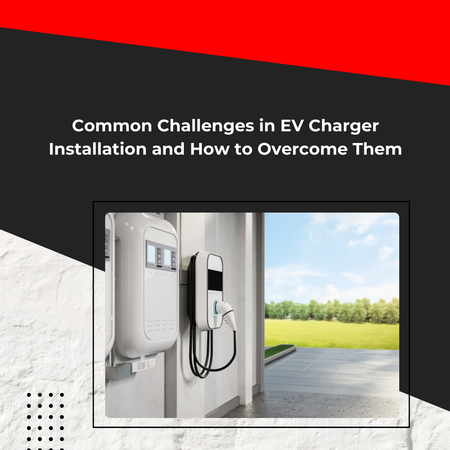Common Challenges in EV Charger Installation and How to Overcome Them

In the dynamic landscape of transportation, the shift towards electric vehicles (EVs) is more than a trend—it's a transformative journey towards a sustainable future. As the world embraces the clean energy revolution, the installation of Electric Vehicle Chargers (EVSE) plays a pivotal role in supporting the widespread adoption of electric vehicles. However, like any technological transition, the installation of EV chargers comes with its own set of challenges.
In this blog, we will explore the common hurdles faced in the process of EV charger installation and delve into effective strategies to overcome them. From navigating regulatory complexities to addressing infrastructure limitations, the electrification of our roads demands innovative solutions and a collaborative effort from stakeholders across the board.
Join us on a journey through the intricacies of EV charger installation, where we'll unravel the challenges and provide insights into how communities, businesses, and policymakers can work together to pave the way for a future where electric vehicles are not just a choice but a sustainable reality. Let's charge ahead into the world of EV infrastructure, where each obstacle presents an opportunity for progress, and every connection made sparks a cleaner, greener tomorrow.
Infrastructure Limitations:
Challenge: One of the primary challenges in EV charger installation is the existing infrastructure limitations. Many locations lack the necessary electrical infrastructure to support high-powered EV charging stations, especially in older buildings or rural areas.
Solution: Collaboration with local utilities and governments is essential. Conducting thorough site assessments to determine the available power capacity and working closely with utility companies to upgrade infrastructure can help overcome this challenge. Additionally, strategic placement of charging stations in areas with better electrical capacity can optimize the use of existing infrastructure.
Regulatory Hurdles:
Challenge: Different regions and municipalities have varied regulations and permitting processes for EV charger installations. Navigating through these regulatory hurdles can be time-consuming and challenging for businesses and individuals looking to install charging stations.
Solution: Staying informed about local regulations and building strong relationships with relevant authorities is crucial. Engaging in proactive communication with local government agencies, obtaining necessary permits, and participating in community outreach can help streamline the regulatory approval process. Advocacy for standardized permitting processes at higher administrative levels can also contribute to a more efficient and consistent approach.
Costs and Financial Viability:
Challenge: The cost associated with EV charger installation can be a significant barrier, including expenses related to equipment, electrical upgrades, and installation labour. Achieving financial viability while providing affordable charging options for users is a complex challenge.
Solution: Leveraging available incentives and subsidies for EV infrastructure development can offset installation costs. Exploring partnerships with government programs, utility companies, and private investors can provide financial support. Additionally, businesses can adopt innovative business models, such as revenue-sharing agreements with property owners or integrating charging infrastructure into existing commercial establishments, to enhance the financial feasibility of installation projects.
User Accessibility and Convenience:
Challenge: Ensuring that EV charging stations are easily accessible and convenient for users is crucial for widespread adoption. Issues such as inadequate parking space, inconvenient locations, or a lack of user-friendly features can hinder the overall accessibility and convenience of charging infrastructure.
Solution: Conducting thorough market research to identify high-traffic areas and user preferences is essential. Installing charging stations in easily accessible locations, such as shopping centers, office complexes, and transportation hubs, can enhance user convenience. Integrating smart charging solutions, mobile apps for station location and payment, and providing amenities such as seating and Wi-Fi can contribute to a positive user experience.
Technological Evolution and Compatibility:
Challenge: The rapid evolution of EV charging technologies can pose challenges in terms of ensuring the compatibility and longevity of installed infrastructure. Obsolescence and the need for frequent upgrades can impact the overall efficiency and effectiveness of EV charging stations.
Solution: Investing in scalable and adaptable charging infrastructure is key to addressing technological evolution challenges. Choosing modular and upgradable components and staying abreast of emerging standards ensures that installed systems can accommodate future technological advancements. Collaboration with reputable and forward-thinking technology providers can also help adopt more future-proof solutions, reducing the risk of obsolescence. Regular maintenance and updates should be incorporated into the operational plan to keep the infrastructure technologically
Overcoming challenges in EV charger installation requires a strategic approach. By partnering with Universal Power & Systems, Inc., you're not just installing a charging station – you're investing in a solution tailored to your unique needs.
Get in touch with us today! To learn more about our comprehensive EV charger installation services, please click here. To contact us, please click here or call us at (608) 226-8600.